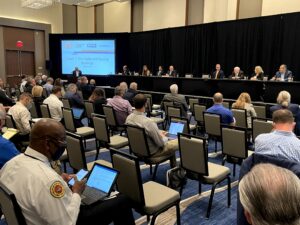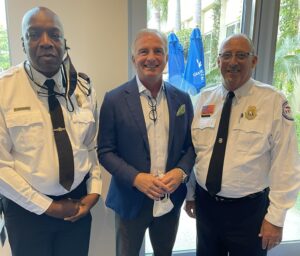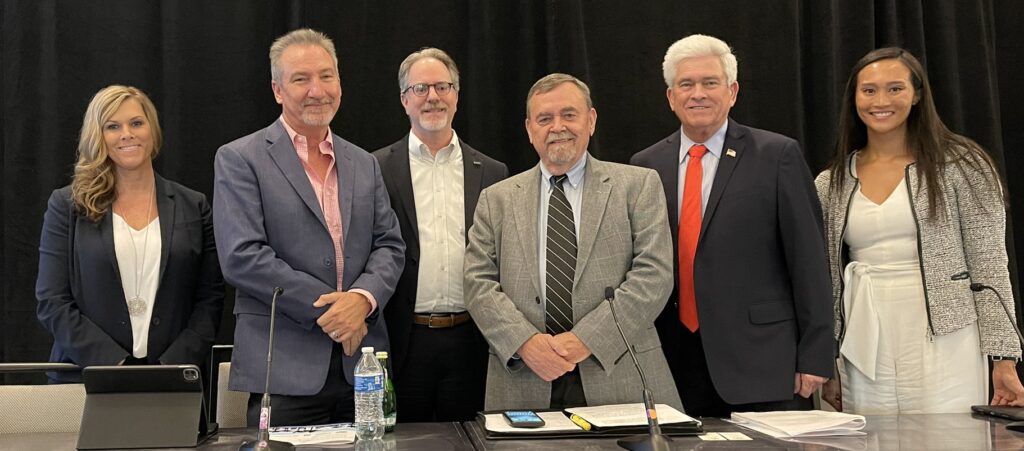
Building safety groups meet in West Palm Beach to discuss the structural safety of existing buildings, frequency of inspections, guidance for building owners
 Building safety organizations from around the country and experts in the building safety community gathered last week on Aug. 17, 2021, at the Hilton Hotel next to the Palm Beach County Convention Center in West Palm Beach, Florida, for an examination on how communities monitor the safety of existing buildings, what guidance exists for building owners, and how future catastrophic events can be avoided. The panel discussion — Ensuring the Safety of Existing Buildings — was hosted by the Building Officials Association of Florida (BOAF) and sponsored by the Building Owners and Managers Association (BOMA) International, the International Code Council, and the National Institute of Building Sciences (NIBS). Representatives from an array of backgrounds — including members of the American Society of Civil Engineers, Insurance Institute for Business & Home Safety (IBHS), National Institute of Standards and Technology (NIST), Structural Engineering Institute, and the University of Florida — joined the discussions, including experts from code enforcement, building, construction, design and real estate.
Building safety organizations from around the country and experts in the building safety community gathered last week on Aug. 17, 2021, at the Hilton Hotel next to the Palm Beach County Convention Center in West Palm Beach, Florida, for an examination on how communities monitor the safety of existing buildings, what guidance exists for building owners, and how future catastrophic events can be avoided. The panel discussion — Ensuring the Safety of Existing Buildings — was hosted by the Building Officials Association of Florida (BOAF) and sponsored by the Building Owners and Managers Association (BOMA) International, the International Code Council, and the National Institute of Building Sciences (NIBS). Representatives from an array of backgrounds — including members of the American Society of Civil Engineers, Insurance Institute for Business & Home Safety (IBHS), National Institute of Standards and Technology (NIST), Structural Engineering Institute, and the University of Florida — joined the discussions, including experts from code enforcement, building, construction, design and real estate.
While the event was held in the wake of the Champlain Towers South condominium collapse, which happened on June 24, 2021, in the Miami beachfront suburb of Surfside, Florida, participants avoided dwelling on the causation of the building collapse and instead focused on the broader questions related to the frequency of inspections, structural safety, maintenance, and the application of current building codes and standards. The dialogue focused on establishing a channel for the building safety community to have a dialogue and develop information that could inform policymakers as they consider questions raised by the tragic collapse of the Champlain Towers South and work with legislators on possible new laws for building safety.
 “We are here today, and our partners are here today, to learn lessons on how we can assure the public that existing buildings are safe,” said Code Council Chief Executive Officer Dominic Sims, CBO. “I think it’s not just about the technical requirements in the code. It’s about making sure that designers, contractors and enforcers all understand what the code says, and to take that a step forward. How do we ensure that?”
“We are here today, and our partners are here today, to learn lessons on how we can assure the public that existing buildings are safe,” said Code Council Chief Executive Officer Dominic Sims, CBO. “I think it’s not just about the technical requirements in the code. It’s about making sure that designers, contractors and enforcers all understand what the code says, and to take that a step forward. How do we ensure that?”
A moment of silence was observed before the first panel discussion in remembrance of the 98 people who were killed in the collapse of Champlain Towers South. As engineers, inspectors and safety experts worked through panels on existing building codes, inspections and property management, the Surfside collapse was an ongoing part of the discussion.
The first session — The Codes and Existing Buildings — covered current building codes and standards that relate to structural safety, existing buildings and property maintenance. Panelists discussed what the codes cover, if there are any gaps and if improvements are needed. Dominic Sims moderated the panel which included Sergio T. Ascunce (BOAF), Tanya Brown-Giammanco (NIST), Joe DiPompeo (SEI), Anne Ellis (NIBS), Michael Fillion (National Council of Structural Engineers Associations), Forrest Masters (University of Florida), Michael Pfeiffer (ICC), and James Schock (Florida Building Commission).
Buildings generally are only required to remain up to the code in place at the time of their construction. Many panelists agreed that residents need to know more about building codes and inspection timelines and that it’s important to acknowledge that building codes, and even a rigorous inspection and recertification regime, alone won’t guarantee that all building failures will be prevented. As saltwater is thought to speed the deterioration of buildings along the coast, experts are recommending earlier inspections of these coastal structures. Building officials from across Palm Beach County are considering a new program that calls for recertification of buildings east of Interstate 95 every 25 years. Buildings west of Interstate 95 would be recertified every 35 years. Palm Beach County commissioners indicated no qualms with the proposed frequency of the inspections, the need for electrical or waterproofing review, or specifically which buildings should undergo regular scrutiny.
 The second session — Building Inspections — covered the current process for building inspections, including current guidelines for frequency and how they are performed. Panelists discussed what recommendations, practices or technology will enhance building inspections in the future and what additional resources (such as training) building safety professionals would need. Drew N. Rouland, vice president of NIBS, moderated the panel which included Tom Allen (Lake County Building Services), William Bracken (J.S. Held LLC), Anne Cope (IBHS), Judy Frydland (Attorney at Law LLC), Robert Hertle (BPVI), Roberto T. Leon (Virginia Polytechnic Institute and State University), Jon Pasqualone (Florida Fire Marshals & Inspectors Association), John C. Pistorino (Pistorino & Alarm Consulting Engineers, Inc.), William Sklar (Condominium Law and Policy on Life Safety Task Force), and Bill Truex (Truex Preferred Construction and Charlotte County Commissioner).
The second session — Building Inspections — covered the current process for building inspections, including current guidelines for frequency and how they are performed. Panelists discussed what recommendations, practices or technology will enhance building inspections in the future and what additional resources (such as training) building safety professionals would need. Drew N. Rouland, vice president of NIBS, moderated the panel which included Tom Allen (Lake County Building Services), William Bracken (J.S. Held LLC), Anne Cope (IBHS), Judy Frydland (Attorney at Law LLC), Robert Hertle (BPVI), Roberto T. Leon (Virginia Polytechnic Institute and State University), Jon Pasqualone (Florida Fire Marshals & Inspectors Association), John C. Pistorino (Pistorino & Alarm Consulting Engineers, Inc.), William Sklar (Condominium Law and Policy on Life Safety Task Force), and Bill Truex (Truex Preferred Construction and Charlotte County Commissioner).
A couple of themes came up repeatedly during the panel discussions: homeowner associations and building inspections. Miami-Dade and Broward counties require buildings to be recertified for safety every 40 years and homeowner associations — often comprised of cost-conscious residents whose numbers and consistent voting patterns make them a political juggernaut — determine which experts examine their buildings and when. Reportedly, the board of Champlain Towers South knew about structural issues from a 2018 engineering report and were about to commence with millions of dollars in repairs when it collapsed. The costs of those repairs were going to be borne by the association members/residents, who balked at paying for the extensive improvements. Records show that contentious debate about the multimillion-dollar repairs — which ballooned in price from about $9 million to more than $15 million — continued for three years as the building continued to deteriorate.
In the third session — Property Management and the Real Estate Industry — panelists explored building safety from the perspective of property owners and managers. Experts discussed what the responsibilities and best practices of building management are regarding operations and maintenance, and examined how the overall system of inspections, codes and standards work in practice to promote the safety of existing buildings. Ken Rosenfeld, director of state and local affairs at BOMA International, moderated the panel which included Mary Lantz (Jones Lang LaSalle Inc.), Daniel L. Lavrich (Broward County Board of Rules and Appeals, Florida Building Commission Structural Technical Advisory Committee), Clayton Parker (City of Sunny Isle Beach), John Scott (Colliers International), and Nicole Upano (National Apartment Association).








